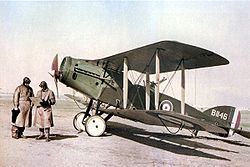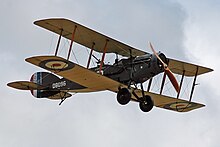Bristol F.2
| Bristol F.2 | |
|---|---|
 Australian F.2B in Palestine, February 1918 |
|
| Type: | Fighter plane |
| Design country: | |
| Manufacturer: | |
| First flight: |
September 9, 1916 |
| Production time: |
1916 -? |
| Number of pieces: |
5329 |
The Bristol F.2 Fighter was a two-seat biplane - fighter plane and arrived in the First World War from 1916 are used.
The plane was also known colloquially as the Bristol Fighter , Brisfit or Biff . Although designed as a two-seater, the agile F2.B was able to keep up with the single-seater Bristol Scout . After initial difficulties, the solid construction became a great success. It remained in military service until the 1930s and was also used successfully as a civilian version.
history
It was built by the Bristol Airplane Company . The first model was the Bristol Type 12 F.2A , whose maiden flight took place on September 9, 1916. The second prototype flew on October 25, 1916. The design came from Frank Barnwell's Type 9 R.2A . This was a two-legged biplane with a uniform span, which was equipped with a 120 hp (89 kW) Beardmore engine . The F2.A was powered by a 190 hp (142 kW) Rolls Royce Falcon I in-line engine. The series machines got a revised engine fairing. In addition, the profile of the wings has been changed. The pilot's seat was no longer protected with reinforcement. The machine was armed with a forward-firing 0.303-inch (7.7-mm) Vickers machine gun , the installation of which required a tunnel in the fuel tank in the upper fuselage, and a rotating Lewis machine gun in the observer position. Only 52 F.2A machines were built.
Improvements eventually led to the definitive Bristol Type 22 F.2B , which first flew on September 25, 1916. The first 150 machines had Falcon I or II engines, the rest received 275 hp (205 kW) Falcon III engines. The machine reached 198 km / h with the Falcon III engine. Hispano-Suiza and Sunbeam-Arab engines, however, could not convince. The F.2B was 16 km / h faster than the F.2A and climbed 3 minutes faster to 3000 m. The observer position received a second Lewis MG.
The first F.2A should attack the enemy in formation flight and take them into crossfire . The tactic turned out to be a failure. When the F.2A took part in the Battle of Arras in April 1917 , disaster broke out. Four of the six planes launched were shot down by five Albatros D.III of the Jasta 11 under the leadership of Manfred von Richthofen . The pilot William Leefe Robinson was captured. A fifth machine was badly damaged.
The tactics have been revised; now the planes flew like single-seaters alone. The forward-firing Vickers machine gun, the high speed and the maneuverability increased the successes and the losses decreased.
In September and October 1917, 1600 F.2B machines were ordered; they remained in use until the end of the war. The Royal Air Force had 1,583 machines in service. A total of 5,329 machines were likely built, most of them at Bristol. The other machines were built by Standard Motors , Armstrong Whitworth and Cunard Steamship Company . In addition, other British Empire air forces flew the F.2B, mainly in the Middle East , India and the Republic of China . There they were often used as light bombers .
The F.2B also served in the RNZAF and RAAF as well as in Poland , Belgium , Canada , Ireland , Greece , Mexico , Norway , Peru , Spain and Sweden . In 1932 the last machines were retired from the RAF in India. In New Zealand this did not happen until 1935.
Some F.2B were converted to civil aircraft and named Bristol Tourers . They received a Siddeley Puma engine and closed cockpits and reached 206 km / h.
The Bristol MR1 was an all-metal aircraft based on the F.2A and first flew on October 23, 1917; however, it never went into series production.
Military use
-
 Afghanistan
Afghanistan
- 3 copies
-
 Argentina
Argentina
- Hærens flyvåpen
- Soviet Union Air Force : 2 copies
-
 Yugoslavia
Yugoslavia
- 1 copy
-
 United Kingdom
United Kingdom
Technical specifications
| Parameter | Data Bristol F.2B Fighter |
|---|---|
| crew | Pilot and observer |
| length | 7.87 m |
| span | 11.96 m |
| height | 2.97 m |
| Wing area | 37.62 m² |
| Empty mass | 975 kg |
| Takeoff mass | 1474 kg |
| Top speed | 198 km / h at an altitude of 1525 m |
| Service ceiling | 5485 m |
| Range | k. A. |
| Engine | 1 × 12-cylinder in-line engine Rolls-Royce Falcon , 275 PS (202 kW) |
| Armament | 1 x 7.7 mm Vickers MG , 2 x 7.7 mm Lewis MG; 108 kg bombs |
Preserved copies
Today there are still three airworthy F.2Bs built by Bristol:
- The oldest aircraft of the trio is the D-7889 of the Historic Aircraft Collection , which was built in 1917/1918. The maiden flight of the restored D-7889 took place on June 6, 2006.
- The D-8084 of the Fighter Collection , which has been airworthy since June 30, 1998.
- The D-8096 , which was flown for the first time by the Shuttleworth Collection in February 1952 and for a long time was the only airworthy F.2B.
See also
literature
- Aero, issue 40, pp. 1118 and 1119
- Scale Aircraft Drawings, pp. 22-26, Air Age, ISBN 0-911295-02-X .
Web links
- F.2B from the Shuttleworth Collection
- Flight demonstration
- Original footage of an SE5 Squadron and a Bristol F2 Fighter


